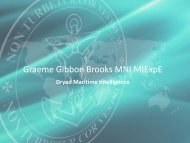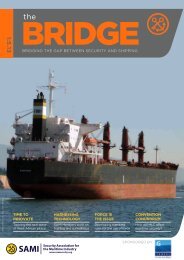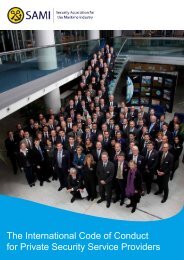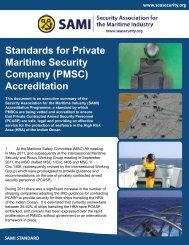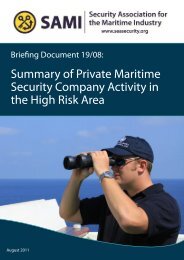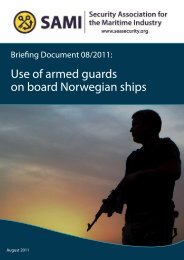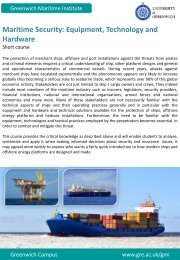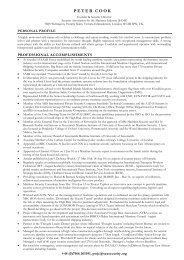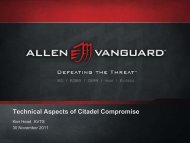SAMI Briefing Maritime Labour Convention FAQs and Text March 2013
SAMI Briefing Maritime Labour Convention FAQs and Text March 2013
SAMI Briefing Maritime Labour Convention FAQs and Text March 2013
You also want an ePaper? Increase the reach of your titles
YUMPU automatically turns print PDFs into web optimized ePapers that Google loves.
SEA of this kind would probably need to be accompanied by clear information, referred toin St<strong>and</strong>ard A2.1, paragraph 1(d), enabling each seafarer to find out what his or her rightsare under the applicable collective bargaining agreement. The effect of Regulation 2.1,paragraph 3, quoted above, is that even if the SEA contains no clear statementincorporating an applicable CBA, it should be understood as incorporating that CBA if alinkage of this kind is compatible with the flag State’s law <strong>and</strong> practice.C2.1.d. Who must sign a seafarers’ employment agreement (SEA)?In accordance with St<strong>and</strong>ard A2.1, paragraph 1(a) of the MLC, 2006, the seafarers’employment agreement (SEA) must be signed by both the seafarer <strong>and</strong> the shipowner or arepresentative of the shipowner. Except in cases where the applicable national lawconsiders that a particular person, such as the ship’s master, has apparent authority to acton behalf of the shipowner, any signatory other than a shipowner should produce a signed“power of attorney” or other document showing that he/she is authorized to represent theshipowner [see B14. Who is the shipowner under the MLC, 2006?].C2.1.e. Can the employer of a seafarer supplying a seafarer to the ship sign the seafarers’employment agreement (SEA) as the shipowner?The term “shipowner” is defined comprehensively in Article II, paragraph 1(j) of theMLC, 2006 as “the owner of the ship or another organization or person, such as themanager, agent or bareboat charterer, who has assumed the responsibility for the operationof the ship from the owner <strong>and</strong> who, on assuming such responsibility, has agreed to takeover the duties <strong>and</strong> responsibilities imposed on shipowners in accordance with this<strong>Convention</strong>, regardless of whether any other organizations or persons fulfill certain of theduties or responsibilities on behalf of the shipowner” [see B14. Who is the shipownerunder the MLC, 2006?].The intention of the drafters of the MLC, 2006 was that there could only be oneperson – namely, “the shipowner” – who assumes, vis-à-vis each seafarer, all the duties<strong>and</strong> responsibilities imposed by the <strong>Convention</strong> on the shipowner. While another personsupplying a seafarer to the ship may have concluded an employment contract with thatseafarer <strong>and</strong> be responsible for implementing that contract, including payment of wages,for example, the shipowner will still have the overall responsibility vis-à-vis the seafarer.Such an employer could therefore only sign the SEA as a representative of the shipowner(assuming that the employer has a signed power of attorney from the shipowner).C2.1.f. Do self-employed seafarers have to conclude a seafarers’ employment agreement(SEA)?Where seafarers are not employees, they do not have to have a seafarers’ employmentagreement (SEA), but – in accordance with St<strong>and</strong>ard A2.1, paragraph 1(a) – there wouldneed to be signed evidence of contractual or similar arrangements “providing them withdecent working <strong>and</strong> living conditions on board” as required by the MLC, 2006.C2.1.g. What is the record of employment for seafarers?The St<strong>and</strong>ard A2.1, paragraph 1(e) requires seafarers to be given a documentcontaining a record of their employment on board the ship. The MLC, 2006 does notdefine or have a specific model for this document, but provides the following information:record of employment must not contain any statement as to the quality of the seafarers’work or as to their wages. The form of the document, the particulars to be recorded <strong>and</strong> themanner in which such particulars are to be entered, are to be determined by national law(St<strong>and</strong>ard A2.1, paragraph 3) <strong>and</strong> should contain sufficient information, with a translationin English, to facilitate the acquisition of further work or to satisfy the sea-serviceFAQ 23




